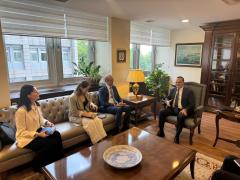- عربي
- 中文
- English
- Français
- Русский
- Español
LDC Insight #8: By stepping up efforts towards gender equality, e-commerce can become an inclusive and empowering space for everybody
23 August 2023 / Simonetta Zarrilli
Accessing the Internet and making a productive use of it
To engage in e-commerce, access to the Internet and a mobile phone, a computer or a tablet are the minimum requirements. Low use figures, especially in the least developed countries (LDCs), are driven by multiple factors, including affordability. It is estimated that in East Africa only 10 to 20 per cent of informal cross-border traders, a particularly vulnerable social group, own a mobile phone.1 The type and quality of the device utilized to access the Internet has an impact on use and outcomes, as mobile phones tend to be inferior to computers for a variety of educational, skill development and business uses. Subscription costs also impinge on access to the Internet. For example, a simple data-only mobile subscription costs more than 6 per cent of average per capita income in the LDCs; conversely, its cost is only 1.5 per cent and 0.5 per cent of average per capita income in other developing countries and in developed countries, respectively (Source: ITU database).
Internet access does not necessarily reflect use. An ITU survey identifies lack of digital literacy, limited understanding of the benefits of Internet usage, and high cost as the main reasons for not using the Internet.2 Two additional factors play a role in the limited demand for the Internet and in the comparatively more widespread use of mobile phones for voice and text services in the LDCs. First, a lack of access to smartphones; second, a lack of relevant content available in languages that the potential users master.3
Internet use, in turn, does not automatically lead to productive use. Using the Internet for personal communications or entertainment is different from making productive use of it. Generally, more education and a higher income leads to more informational, educational, and career-enhancing Internet use.4 Factors - including geography (global North- global South, urban-rural), social class, age, gender, ethnicity, income, assets, and cultural origin - determine how and for which purposes people use the Internet. The ensuing danger is that pre-existing socioeconomic inequalities are entrenched in the digital environment.
The challenges for women entrepreneurs
Gender gaps in society and in the economy and digital gender divides lead to women entrepreneurs facing compounding disadvantages when seeking to leverage the potential benefits of e-commerce. This is particularly the case in the LDCs. Women-owned enterprises face numerous obstacles to making their business grow and diversify, including less start-up capital, less access to finance and other productive resources, limited business networks, lower levels of entrepreneurial skills, business presence in only a limited number of sectors with low value addition, negative gender stereotypes, and time poverty. These obstacles, which result in women’s businesses being on average smaller and less profitable than men’s, tend to also be found in online trade, and are compounded by gender digital divides.
Globally, in 2022, 69 per cent of all men used the Internet, compared with 63 per cent of all women.5 Gender gaps in Internet use have almost been eliminated in developed countries where more than 90 percent of men and women use the Internet. However, large gaps persist especially in the LDCs, where more than 40 per cent of men but only 30 per cent of women use the Internet, as shown in the chart below.
Percentage of female and male populations using the Internet
Source: UNCTAD calculation based on ITU World Telecommunication/ICT Indicators Database, Jan. 2023.
Note: Internet users are individuals who have used the Internet (from any location) in the last three months, when being surveyed. For 2022, not enough data points are available for developing countries to calculate the group average, thus ITU forecasts are used.
No improvements without policy support
To make e-commerce a greater driver of shared prosperity, policymakers must shore up gender considerations in e-commerce policymaking and negotiations.
It took a long time for the trade community to recognize that “traditional” trade is not “gender neutral”. It is time to acknowledge that online trade is not gender neutral either, also because it relies on digital technologies which, in turn, are not gender neutral.
Some positive developments in recognizing how gender gaps and digital divides are interlinked and the need to address them in parallel are already unfolding. The Doha Programme of Action (DPoA) for the Least Developed Countries for the Decade 2022−2031 addresses gender and digital divides, and in some cases links them, recognizing that one divide can amplify the other. The DPoA includes a specific Section on “Achieving gender equality and the empowerment of all women and girls and young people to address inequality and drive economic growth”. The actions the LDCs and their development partners have committed to take include providing universal and affordable access to the Internet and ensuring that the benefits of new technologies are available to all (paragraph 100), as well as increasing LDCs’ cyber resilience and making their cyber ecosystems more secure, including for women and children, so that they can serve national priorities and maximize socioeconomic benefits (paragraph 104). Similar commitments to improving human and institutional capacity regarding the use of digital tools and to strengthening the related infrastructure are listed as preconditions for the integration of the LDCs into digital value chains and the global economy (paragraphs 186 and 187).
In recent Free Trade Agreements (FTAs), some countries are linking the commitments to furthering gender equality and women’s economic empowerment with those related to facilitating women’s participation in digital trade. This is the case, for example for the UK-New Zealand FTA. The agreement contains a Digital Trade chapter and a Trade and Gender Equality chapter. The latter identifies among the areas of cooperation to enable women’s access to online business tools and opportunities, strengthening digital skills and identifying and addressing obstacles to women’s accessing digital trade. The chapter also refers to cooperation to improve women’s access to leadership opportunities and education in STEM, and confirms the objective of facilitating women’s participation in digital trade. The Digital Trade chapter refers to the Trade and Gender Equality chapter and confirms the objective of facilitating women’s participation in digital trade. Moreover, the Parties commit to work together to address challenges faced by SMEs when engaging in digital trade, and recognize the importance of enhancing the cybersecurity capabilities of such enterprises. Thus, the Trade and Gender Equality chapter and the Digital Trade chapter support and reinforce each other.6
Following the same approach taken in the landmark Buenos Aires Declaration on Trade and Women’s Economic Empowerment,7 countries could commit to sharing experiences and best practices, programmes and policies for encouraging women’s participation in e-commerce. They could also share initiatives that have allowed leveraging digital technology to improve women’s access to capital, participate in government procurement opportunities, and other measures that have helped women-led micro and small enterprises adapt to digital trade. They could carry out ex-ante gender assessments of digital and e-commerce policies before enacting them.8
In the framework of the AfCFTA negotiations, two protocols are under discussion, on Women and Youth, and on Digital Trade. The former was not foreseen at the outset and the decision to include it in the AfCFTA agreement was only taken in February 2022 by the AU Assembly. The suitability to develop a protocol on digital trade was agreed upon by the AU Assembly in February 2020.
The approval by the AU Assembly of the development of a protocol on women and youth reflects the aim to make AfCFTA’s expected gains available to all. Negotiating the two protocols in parallel may provide the opportunity to link and boost the commitments they will contain and break the vicious circle that makes gender and digital divides magnify each other.
What is presented so far are positive developments. A more challenging step would be to tackle gender-specific challenges that are the root causes of women’s still limited ability to fully benefit from e-commerce and that act as productivity barriers and drivers of exclusion. Many countries may not be ready to make a big leap and address issues such as women's access to education or to trade finance, or gender labour segregation, or discriminatory gender norms when discussing offline and online trade. Many countries may regard these issues as pertaining to other fields of work and other constituencies.9
Two outcomes may then be envisaged. The current "step by step" approach may make it possible to increasingly incorporate gender considerations when dealing with e-commerce and eventually address the causes undermining women’s ability to fully benefit from it. The second possible outcome is that countries’ commitments will continue to be “mild”. They will be limited to recognizing the potential of e-commerce for women entrepreneurs and the gendered obstacles they face without, however, taking strong positions to overcome them or questioning the root causes of them. Hopefully the first option will prevail.
Simonetta Zarrilli is the Chief of the Trade, Gender and Development Programme of the United Nations Conference on Trade and Development (UNCTAD), a programme she launched in 2010 and has been leading since. Under her leadership, the Programme provides analytical, policy and capacity-building support to member countries on the gender implications of trade policy.
1 Hadley, L. and Aoko, E. (2022), “Smartphone Adoption Among Traders in Kenya and Uganda”. Nairobi, Kenya: Sauti East Africa.
2 International Telecommunication Union (ITU) (2022). Measuring Digital Development: Facts and Figures. 2022. Geneva: International Telecommunication Union.
3 Ibid.
4 Zillien, N. and Hargittai, E. (2009). “Digital Distinction: Status‐specific Types of Internet Usage”. Social Science Quarterly, 2009; 90(2): 274-−291.
5 ITU. (2022). Ibid.
6 United Nations Conference on Trade and Development (UNCTAD) (2023). E-Commerce from a Gender and Development Perspective. Geneva: United Nations.
7 The declaration was adopted at the margins of the WTO Buenos Aires Ministerial Conference (MC11) in December 2017. It has been endorsed by 127 WTO members and observers.
8 UNCTAD. (2023). Ibid.
9 Zarrilli, S. (2022). “If a first you do not succeed, try women’s economic empowerment through trade”. Blog. Trade Experettes.







